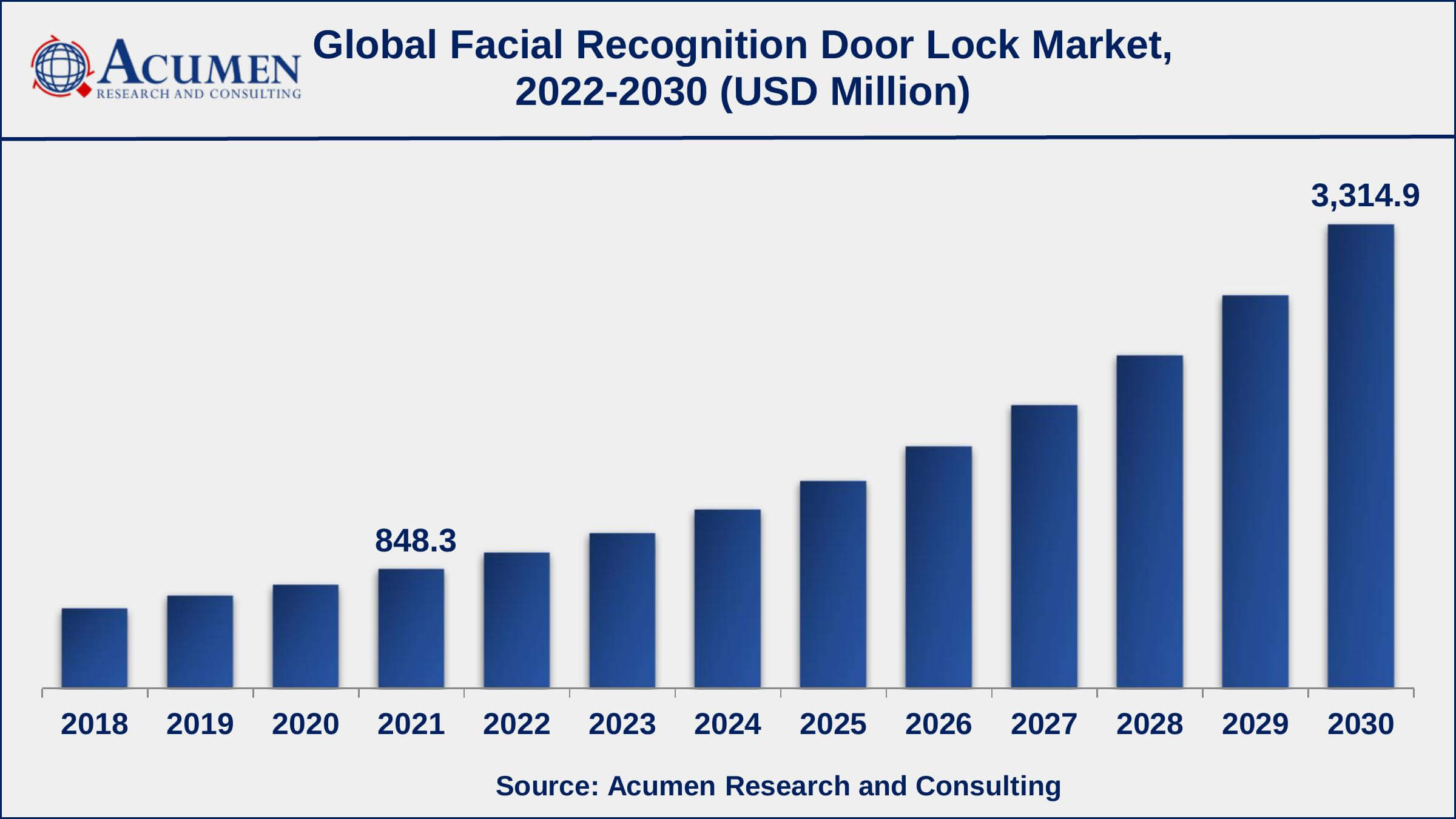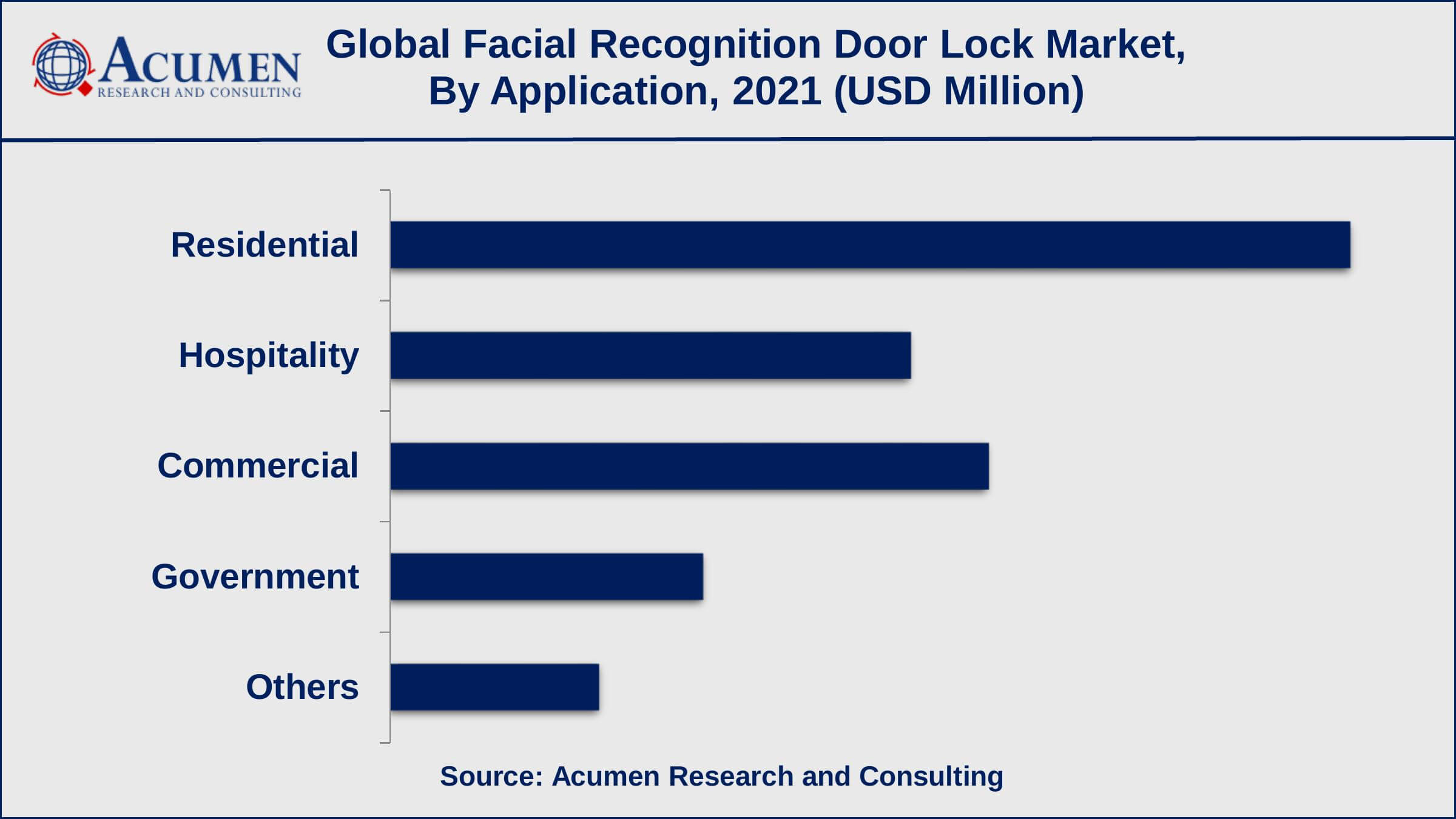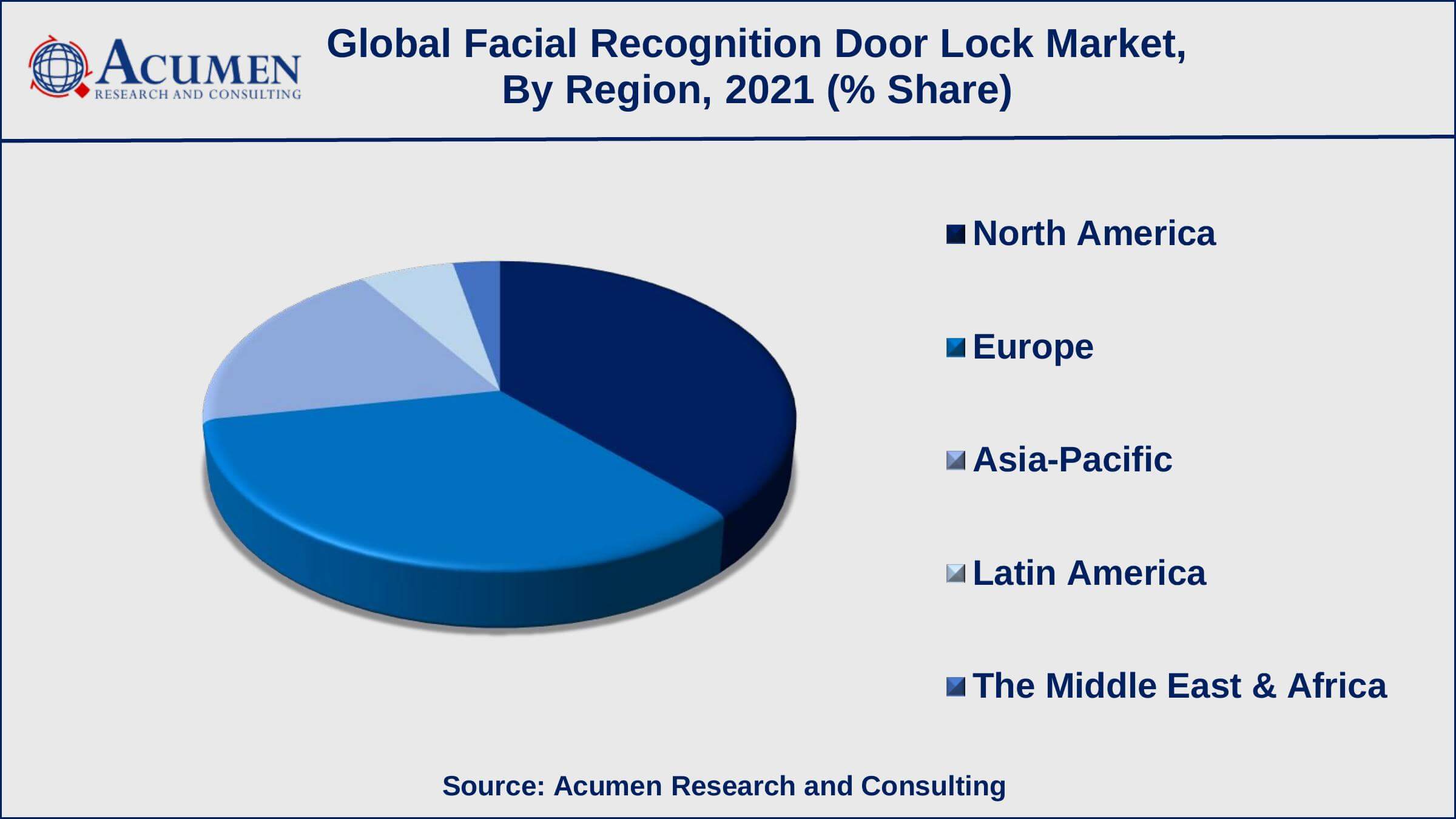Facial Recognition Door Lock Market | Acumen Research and Consulting
Facial Recognition Door Lock Market Size - Global Industry, Share, Analysis, Trends and Forecast 2022 - 2030
Published :
Report ID:
Pages :
Format :
The Global Facial Recognition Door Lock Market Size was valued at USD 848.3 Million in 2021 and is projected to occupy a market size of USD 3,314.9 Million by 2030 growing at a CAGR of 16.6% from 2022 to 2030.
Facial recognition door locks use a camera and computer vision software to recognize a person's face and unlock the door when the person is recognized as authorized to enter. They are becoming more popular for residential, commercial, and government applications as an alternative to standard keyed locks or keypad code entry systems. Face recognition door locks have several advantages, including increased security and convenience, as well as the potential to grant or revoke access to particular individuals without the use of physical keys or access codes. However, there are privacy and accuracy concerns, and the use of facial recognition technology has been the topic of debate and controversy.

Facial Recognition Door Lock Market Report Statistics
- Global facial recognition door lock market revenue is projected to reach USD 3,314.9 million by 2030 with a CAGR of 16.6% from 2022 to 2030
- According to one study, the average for 2016 across 74 countries was 783 thefts per 100,000 people
- North America facial recognition door lock market share gathered more than USD 322.4 million in 2021
- Asia-Pacific facial recognition door lock market growth will record a CAGR of more than 18% from 2022 to 2030
- Based on the application, the residential sub-segment achieved 37% shares in 2021
- Among applications, the commercial sub-segment occupied USD 195.1 million in revenue in 2021
- The increasing integration of AI, big data, and IoT in facial recognition is a popular facial recognition door lock market trend that drives the industry demand

Global Facial Recognition Door Lock Market Dynamics
Market Drivers
- Rising number of theft activities
- Growing safety and security concerns among individuals
- Increased use in commercial and government applications
Market Restraints
- Privacy concerns associated with this technology
- Complexity issues and strict regulatory guidelines
Market Opportunities
- Rising prominence of AI and IoT in safety and security solutions
- Growing technological advancements in the facial recognition industry
Facial Recognition Door Lock Market Report Coverage
| Market | Facial Recognition Door Lock Market |
| Facial Recognition Door Lock Market Size 2021 | USD 848.3 Million |
| Facial Recognition Door Lock Market Forecast 2030 | USD 3,314.9 Million |
| Facial Recognition Door Lock Market CAGR During 2022 - 2030 | 16.6% |
| Facial Recognition Door Lock Market Analysis Period | 2018 - 2030 |
| Facial Recognition Door Lock Market Base Year | 2021 |
| Facial Recognition Door Lock Market Forecast Data | 2022 - 2030 |
| Segments Covered | By Application, And By Geography |
| Regional Scope | North America, Europe, Asia Pacific, Latin America, and Middle East & Africa |
| Key Companies Profiled | Bonwin Technology Co, Brinks Home Security, Corum Security, Elecpro Group, EPIC Systems, Godrej Group, Honeywell International, Inc., iCreation, iView, Kaadas, MD Smart Touch, Samsung Group, and ZKTeco Co., Ltd. |
| Report Coverage |
Market Trends, Drivers, Restraints, Competitive Analysis, Player Profiling, Regulation Analysis |
Facial Recognition Door Lock Market Growth Factors
The increasing number of theft activities is one key factor that is driving the global facial recognition door lock market. Facial recognition door locks can offer a high level of security by allowing only individuals recognized by the system access. This is especially useful for preventing unauthorized access or entry by someone who has stolen a physical key or access code. Because they allow people to enter simply by looking at the camera, facial recognition door locks can be more efficient than traditional keyed locks or keypad code entry systems. This is particularly beneficial for individuals who frequently carry a large number of keys or who struggle to remember complex access codes.
When a person enters the home, some facial recognition door locks can be embedded with other smart home systems and devices, enabling them to perform additional functions such as turning on the lighting system or adjusting the thermostat. In some cases, facial recognition door locks may be more cost-effective in the long run than traditional locks that require physical keys or access codes to be replaced. As facial recognition technology is becoming more widely available and accepted, more people will likely opt for the convenience and security that facial recognition door locks provide.
Some people may be worried about the use of facial recognition technology for door locks because of privacy concerns. They may be concerned about the system's ability to collect and store personal data, as well as the possibility of the system being hacked or used to track their movements. While facial recognition technology has advanced dramatically in recent years, there is still the possibility of errors or false positives, which could result in a person being denied entry to their home or workplace.
Facial Recognition Door Lock Market Segmentation
The worldwide facial recognition door lock market is categorized based on application, and geography.
Facial Recognition Door Lock Market By Application
- Residential
- Hospitality
- Commercial
- Government
- Others

According to the facial recognition door lock industry analysis, the residential sub-segment achieved a substantial market share in 2021. This is due to the growing demand for smart home solutions in a number of countries around the world. Similarly, rising burglary rates, as well as high security risk in urban areas, are expected to drive segment growth. The commercial segment is expected to grow rapidly during the forecast period as commercial building providers become more aware of the benefits of smart security solutions. Smart city projects are expected to increase demand for these systems in commercial buildings.
Facial Recognition Door Lock Market Regional Outlook
North America
- U.S.
- Canada
Europe
- U.K.
- Germany
- France
- Spain
- Rest of Europe
Asia-Pacific
- India
- Japan
- China
- Australia
- South Korea
- Rest of Asia-Pacific
Latin America
- Brazil
- Mexico
- Rest of Latin America
The Middle East & Africa
- South Africa
- GCC Countries
- Rest of the Middle East & Africa (ME&A)

Facial Recognition Door Lock Market Trend
The market for facial recognition door locks may vary by region due to differences in technology adoption, economic conditions, and regulatory environments. The market for facial recognition door locks is likely to be strong in North America, as the region has a high level of technology adoption and a well-developed smart home market. Additionally, the European facial recognition door locks market is expected to be robust, owing to the region's high level of technological adoption and emphasis on security and convenience. Furthermore, as per the facial recognition door lock market forecast, the Asia-Pacific region is expected to have a strong market from 2022 to 2030 due to the region's high level of technology adoption and growing emphasis on security in residential and commercial settings.
Facial Recognition Door Lock Market Players
Some of the leading facial recognition door lock companies include Bonwin Technology Co, Brinks Home Security, Corum Security, Elecpro Group, EPIC Systems, Godrej Group, Honeywell International, Inc., iCreation, iView, Kaadas, MD Smart Touch, Samsung Group, and ZKTeco Co., Ltd.
Frequently Asked Questions
What was the market size of the global facial recognition door lock in 2021?
The market size of facial recognition door lock was USD 848.3 Million in 2021.
What is the CAGR of the global facial recognition door lock market during forecast period of 2022 to 2030?
The CAGR of facial recognition door lock market is 16.6% during the analysis period of 2022 to 2030.
Which are the key players operating in the market?
The key players operating in the global facial recognition door lock market are ABB Group Ltd., Aerobotix, Boeing, FANUC Corporation, Fuelmatics AB, KUKA AG, Mine Energy Solution (MES), Neste, Rotec Engineering, Scott Technology Ltd, Simon Group Holding, and TATSUNO Corporation.
Which region held the dominating position in the global facial recognition door lock market?
North America held the dominating position in facial recognition door lock market during the analysis period of 2022 to 2030.
Which region registered the fastest growing CAGR for the forecast period of 2022 to 2030?
Asia-Pacific region exhibited fastest growing CAGR for facial recognition door lock market during the analysis period of 2022 to 2030.
What are the current trends and dynamics in the global facial recognition door lock market?
The current trends and dynamics in the facial recognition door lock industry include the rising number of theft activities, growing safety and security concerns among individuals, and increased use in commercial and government applications.
Which application held the maximum share in 2021?
The residential application held the maximum share of the facial recognition door lock market.



